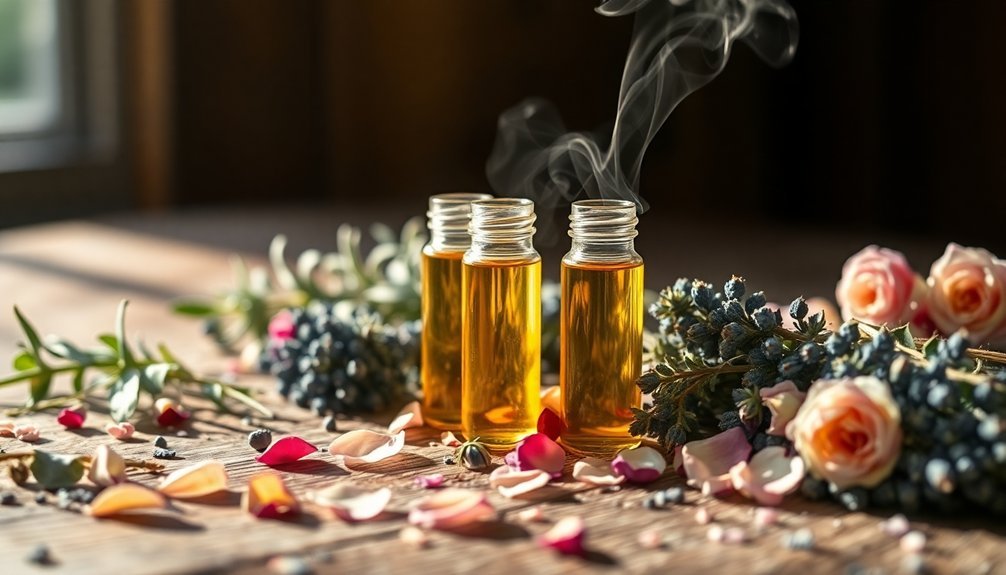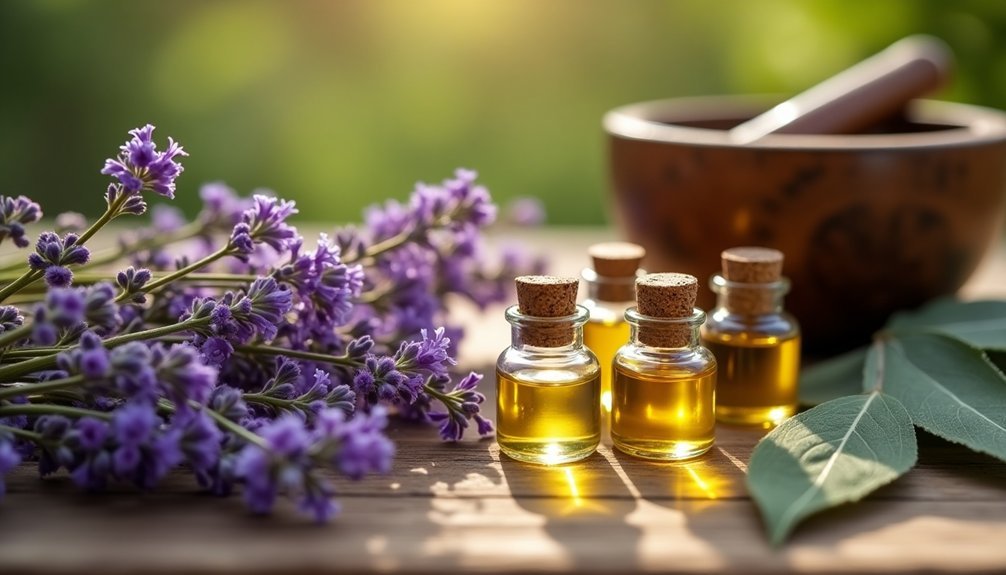Create your own natural perfumes using dried herbs and essential oils with these five aromatic recipes. You'll discover how to make a soothing lavender-mint solid perfume, a sleep-inducing chamomile-rose blend, an invigorating forest walk fragrance with rosemary and pine, a summer garden perfume oil using dried herbs, and an ancient wisdom blend featuring clary sage. Each recipe combines natural ingredients for unique, long-lasting scents that you can customize to your preferences. Let these traditional formulas guide you toward crafting your signature botanical scent.
Creating a Classic Lavender and Mint Solid Perfume

A classic lavender and mint solid perfume combines the soothing properties of lavender with the invigorating zing of mint in a convenient, portable form.
To create this natural fragrance, you'll need sweet almond oil (or jojoba oil), beeswax, lavender essential oil, and peppermint essential oil.
Start by melting 1.5 tablespoons of sweet almond oil with 1 tablespoon of beeswax in a double boiler. This recipe is perfect for gift-giving, as it takes mere minutes to prepare.
Once melted, let the mixture cool to 104°F before adding 15-40 drops of lavender essential oil and 5-10 drops of peppermint oil.
Stir well and quickly pour into small, airtight containers.
Let it set completely before use.
Your solid perfume will last longer than liquid versions and won't spill in your bag.
Apply it to your pulse points throughout the day for a lasting natural scent.
Sweet Dreams Chamomile-Rose Essential Blend
For a peaceful nighttime blend that promotes restful sleep, combine the gentle properties of chamomile with rose essential oils.
Start by mixing 8 drops of chamomile essential oil and 6 drops of rose essential oil with 2 teaspoons of sweet almond oil as your carrier base. The combination creates a delightful aroma with creamy apricot undertones.
To enhance the fragrance, add 1 teaspoon of rose water and infuse dried rosebuds and chamomile flowers in a dark glass bottle.
Pour in a small amount of vodka to help preserve and meld the scents. Let your blend infuse for 2-6 weeks in a cool, dark place, shaking periodically to guarantee even distribution.
If you'd prefer immediate aromatherapy benefits, add 5-8 drops of your essential oil mixture to a diffuser.
Remember to store your blend properly and always dilute before applying to skin.
Forest Walk Rosemary-Pine Natural Fragrance

Transport yourself to a woodland sanctuary with this invigorating Forest Walk blend that captures the essence of a pine-scented morning hike.
You'll combine fresh top notes of eucalyptus, pine, bergamot, lemongrass, and mint to create an uplifting introduction.
For the heart of your fragrance, blend rosemary, sage, lavender, geranium, and clary sage.
These herbal middle notes add depth and character while maintaining the forest-inspired theme.
Ground your creation with base notes of cedarwood, sandalwood, vetiver, patchouli, and frankincense for lasting warmth. Consider adding pine pitch to your base notes, as its natural resin properties help extend the fragrance's longevity.
Mix your essential oils with high-proof perfumer's alcohol or carrier oils like argan or fractionated coconut oil.
Let your blend mature for at least a month to allow the scents to meld perfectly.
You'll find the finished fragrance delivers a remarkable woodland experience.
Summer Garden Herbal Perfume Oil
Moving from the woodland trail to your backyard garden, you'll discover the joyful art of crafting Summer Garden Herbal Perfume Oil.
Start by selecting dried herbs like lavender, clary sage, and chamomile, ensuring they're completely dry to prevent spoilage. Break and chop these herbs to maximize their scent potential.
Choose a non-scented carrier oil such as jojoba or grapeseed, then combine it with your herbs in a crockpot or saucepan. Simmer until the herbs become dry and crunchy, indicating thorough scent extraction.
Strain the mixture using a coffee press or wire strainer. For a stronger fragrance, repeat the infusion process with fresh herbs.
You can transform your oil into a solid perfume by adding grated beeswax in a 4:1 oil-to-wax ratio. Don't forget to add vitamin E to extend shelf life.
Ancient Wisdom Clary Sage and Floral Mix

Drawing from centuries of perfumery wisdom, Clary Sage stands as the cornerstone of this enchanting blend that marries ancient aromatics with delicate florals.
You'll discover its balsamic, tobacco-like aroma creates a perfect foundation for this sophisticated mix.
To craft this timeless blend, you'll need:
- Clary Sage absolute – warm and wine-like base
- Jasmine or Rose essential oil – floral heart notes
- Bergamot or Grapefruit – bright citrus top notes
- Sandalwood oil – woody undertones
Heat your carrier oil gently, then add these ingredients drop by drop.
The Clary Sage's natural fixative properties will help your perfume last longer while adding depth to the florals.
For extra staying power, you can melt beeswax into your blend to create a solid perfume that's perfect for travel.
Frequently Asked Questions
How Long Does Homemade Natural Perfume Typically Last Before Expiring?
Your homemade natural perfume will typically last 1-2 years before expiring, but you'll need to store it properly in a cool, dark place and watch for signs like changes in scent or appearance.
Can I Combine Synthetic Fragrances With Natural Herbs in These Recipes?
Yes, you can combine synthetic fragrances with natural herbs to enhance longevity and complexity. It's actually a smart approach since synthetics can stabilize natural scents and add unique notes that aren't possible with herbs alone.
What Allergic Reactions Are Common With Natural Perfume Ingredients?
You'll commonly experience contact dermatitis with natural perfumes, showing redness and itching. Essential oils like lavender and tea tree can trigger allergic reactions, while herbal extracts may cause skin irritation and rashes.
Does the Color of Dried Herbs Affect the Final Perfume Color?
No, you won't see the dried herbs' colors in your final perfume. The color comes mainly from essential oils and other ingredients, while the herbs contribute only to the fragrance profile.
Can I Make Perfume Using Fresh Herbs Instead of Dried Ones?
While you can use fresh herbs, it's not recommended. They'll spoil quickly, won't give consistent fragrance, and contain too much water. You'll get better results using dried herbs for your perfume making.
In Summary
You've now learned five easy ways to create your own natural perfumes using dried herbs and essential oils. Don't be afraid to experiment with different combinations and ratios to find your signature scent. Whether you're making solid perfumes, oil-based blends, or botanical infusions, you'll enjoy a chemical-free alternative that connects you to nature's timeless fragrances. Start small, keep notes, and let your nose guide you.





Leave a Reply